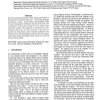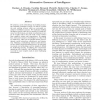399 search results - page 70 / 80 » Humanoid robot HRP-3 |
IROS
2006
IEEE
15 years 5 months ago
2006
IEEE
- This paper presents a three-layer model for generation and recognition of attention-drawing behavior. The model enables a robot to recognize people’s attention-drawing behavior...
HRI
2010
ACM
15 years 4 months ago
2010
ACM
—Based on a study of the engagement process between humans, we have developed and implemented an initial computational model for recognizing engagement between a human and a huma...
ICRA
2000
IEEE
15 years 3 months ago
2000
IEEE
We have proposed the practical torque sensqng which utilizes a flexible part of a harmonic drive gear. The sensing technique providesjoint torque sensing without reducing stiffnes...
113
click to vote
ISER
1995
Springer
15 years 2 months ago
1995
Springer
Most robot designers make the mechanical interface between an actuator and its load as stiff as possible[9][10]. This makes sense in traditional position-controlled systems, becau...
100
click to vote
AAAI
1998
15 years 20 days ago
1998
We present a novel methodology for building humanlike artificially intelligent systems. We take as a model the only existing systems which are universally accepted as intelligent:...


